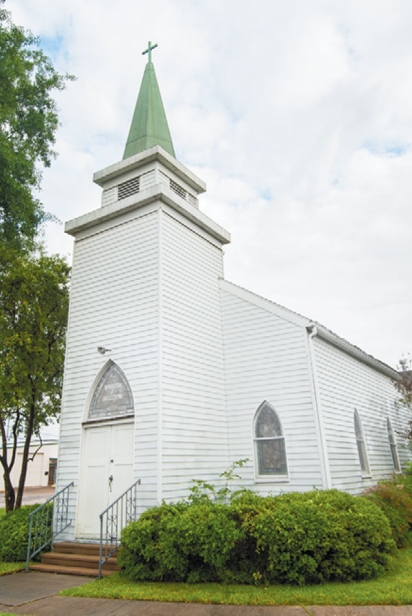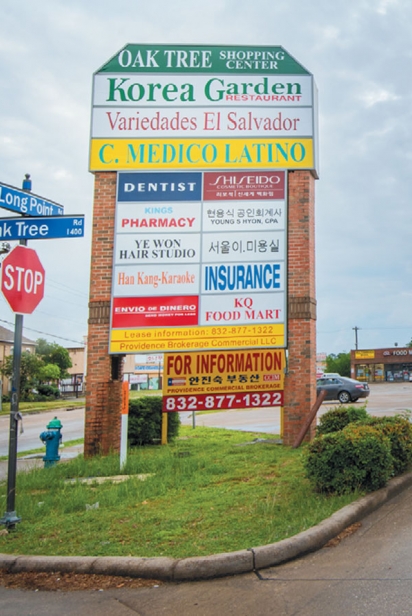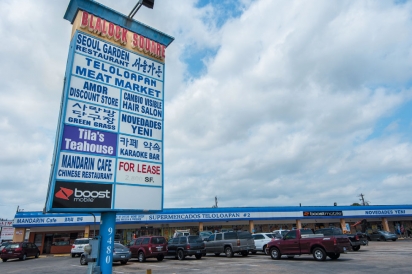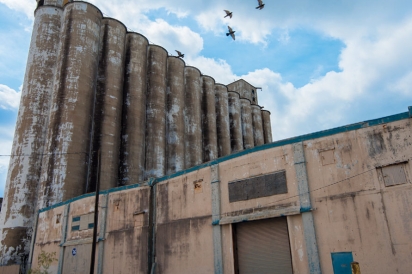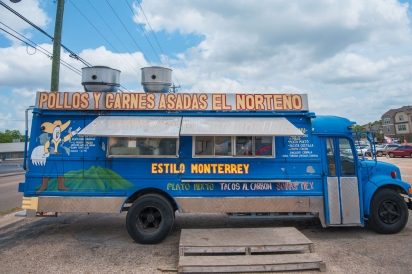Long Point Road--One Road A Long History and Many Cuisines
On the surface, Houston’s Long Point Road is a typical stretch of concrete bisecting an aging sprawl of manufacturers and warehouses, garden apartments, neighborhoods of 1950s-to-’80s ranch houses and low-slung strip malls fronted by parking lots. But dig a little deeper and you’ll find that it has been shaped by global history: the German revolutions of 1848, the Mexican Revolution, Latin American’s Cold War politics, the rise of OPEC, oil booms and busts, the authoritarian regime of South Korean leader Park Chung-hee (1961–79) and much more. You’ll also discover that it is one Houston’s great food roads.
Traveling east to west as a main artery for Spring Branch, Long Point begins at Hempstead Highway, where an old grain elevator looms over ramshackle warehouse-based businesses and backyards with chickens. It ends 5.3 miles later just past Gessner, when Long Point enters a residential neighborhood and becomes Shadow Oak Drive. Between those points lies a vast array of restaurants, grocery stores and other businesses primarily owned by or catering to Mexicans, Ecuadorians, Hondurans, Salvadorans and Koreans—just a few of the immigrant populations that make Houston the most diverse city in the United States.
But it’s also a road rooted in Houston’s history, especially its long history of immigrants playing key roles in its food systems. In 1839, Jacob and Dorothea Schroeder became the first German immigrants to settle in what became Spring Branch, which is named after a tributary of Buffalo Bayou. Other German families soon followed, many escaping revolution and oppressive principalities. They set up small-scale farms to produce vegetables, corn, dairy and livestock, which some hauled down Washington Road (now Hempstead Highway) to sell at Houston’s City Hall Market House and to the wholesalers on Produce Row.
By 1854, there was a large enough German population to build a log cabin sanctuary for St. Peter’s Lutheran on the wagon trail that would become Long Point. The community continued to grow throughout the 19th century as schoolteachers, blacksmiths, bakers and sawmill operators joined the farmers. These German homesteads eventually became early links in a loose ring of farms, many operated by immigrants, that surrounded Houston and helped supply it with produce, meat and dairy.
According to historical documents provided by Dan Worrall of the Harris County Historical Commission, what would become Long Point was first surveyed in 1890. It was to run from the Houston & Texas Central Railroad to Long Point, a now-submerged feeder for Buffalo Bayou that gave the road its name. Construction on the road began shortly after.
The area remained primarily rural until the 1950s, when the city of Houston’s exponential population growth—between 1890 and 1960 the population grew from 27,557 to 938,219—reached Spring Branch. In 1962, the Houston Chronicle took poignant photos of Arnold and Etta Hillendahl, descendants of one of the area’s first German families, farming on Long Point as a Kmart was being built nearby.
According to sociologist Victoria Hyonchu Kwon, economic modernization, Cold War politics, the dictatorial regime of Park Chung-hee and the liberalization of U.S. immigration policies in 1965 led to a major increase in South Korean immigration to the United States. Between 1950 and 1965, only 15,000 Koreans immigrated to the U.S. By 1990, an estimated 800,000 Korean immigrants lived here, many in the Houston area. By January 1983, just 20 years after the Hillendahls were farming with a mule, Alison Cook in the Texas Monthly discussed the restaurants in the Korean community forming on Long Point.
Similar political and economic factors led to an increase in Central American and Mexican immigration to Houston in the 1970s and 1980s. Writer Carlos Herbert Hernandez, who grew up a block south of Long Point, told me:
“Since the 1930s, El Salvador had been a military dictatorship. At the end of the 1970s, five revolutionary groups, inspired by Sandino, the Bay of Pigs and other Cold War movements, swept the tiny nation. My grandma experienced these deadly events firsthand, struggling in a tenement in San Salvador, El Salvador. Able only to take her youngest child, she left her teenage daughters, my mom and aunt, behind with relatives until she could send for them, paying for each leg of their excursion as she raised the money. Eventually, they ended up in Spring Branch, at the intersection of Gessner and Westview.”
These waves of immigration corresponded with Houston’s 1980s oil bust, which drove down real estate prices, making it more affordable for immigrants to live and start businesses. One expression of the resulting diversity is the many international food establishments along Long Point.
Though Long Point doesn’t display the Vietnamese influence like Bellaire does, it is bookended by two Vietnamese restaurants. On the east end, in an unassuming strip center, is Kim Châu, where you can get a good bowl of bún bò hue, the well-balanced, spicy and sour central Vietnamese soup made with beef-lemongrass stock and rich, tasty cubes of congealed pig’s blood. At the western end of Long Point is newcomer Roostar Vietnamese Grill, which features well-constructed bánh mì.
Just up the road from Kim Châu is Vieng Thai, where I’ve enjoyed e-sarn sausage, a sour pork delicacy, while listening to country music played by Anglos and Thais—one of those very Houston moments.
Though Latin American and East Asian foods weave their way along the entire length of the road, the eastern half of Long Point features more Latino food. A few blocks from Vieng Thai are two of Houston’s best taco trucks: El Ultimo and Taqueria El Taconazo.
Farther west, Central American food is represented at Mi Bella Honduras, selling hearty baleadas sencillas con frijoles and pastelito de carne molida y arroz (a Honduran empanada), and at Cocina Latina Pupusa Buffet, where you can enjoy a variety of papusas, thick corn tortillas stuffed with cheese or other savory fillings that originated in El Salvador.
At the corner of Hillendahl Boulevard, you’ll find Tacos Del Julio, an import from Monterrey, Mexico—birthplace of many Houston immigrants including famous restaurateur Felix Tijerina. There you can sample regional specialties such as tacos de trompo and tostada estilo siberia, two fried corn tortillas stuffed with shredded chicken, guacamole, crema and queso.
Farther down, in a Chevron station parking lot at the corner of Gessner and Long Point, is a dark blue school bus emblazoned with cartoon chickens and bright yellow letters that read Pollos Y Carnes Asadas El Norteño. Here you can try another Monterrey specialty: a whole chicken grilled and smoked over mesquite with all the fixings: grilled onion and jalapeños, corn tortillas and salsa.
Between these two points, at the corner of Bingle and Long Point, where German immigrant Louis Hillendahl established a farm in 1847, stands Las Tortas Perronas, which serves some of Houston’s best Mexican sandwiches—masterpieces layered with meats such as jamón, milanesa, breaded skirt steak and pork leg.
As you cross Blalock heading west, you’ll see an increasing number of signs displaying the distinctive Korean alphabet. On your right, in a strip center that includes a Latino supermarket, is Seoul Garden. Opened in 1994, it has long been a go-to spot for cook-your-own Korean barbecue—your choice of several different meats served with rice and sides like spicy cucumbers and kimchi.
If you head south on Blalock, you quickly come to one of Houston’s best grocery stores, Super H Mart, a Korean grocery that features food from all over East Asia. It also has an amazing food court where you can indulge in spicy Korean fried chicken at ToreOre and good bibimbaps and other vendors there.
Across from Seoul Garden is what some consider Houston’s best Korean restaurant, Korea Garden, which opened in 1983. In its inviting dining room you can grill bulgogi, marinated slices of rib eye; enjoy a kimch jjigae, a spicy tofu stew; and try a variety of crispy, savory pancakes like hae mool pah jeon, which is composed of scallions and seafood.
This just scratches the surface of the food, history and complexity of Long Point. Every household, every building, every business, every person you see has a story—stories that link us to global history and that can help us better understand each other. Food can be gateway to those stories and to that understanding. But first you have to hit the road and explore.



